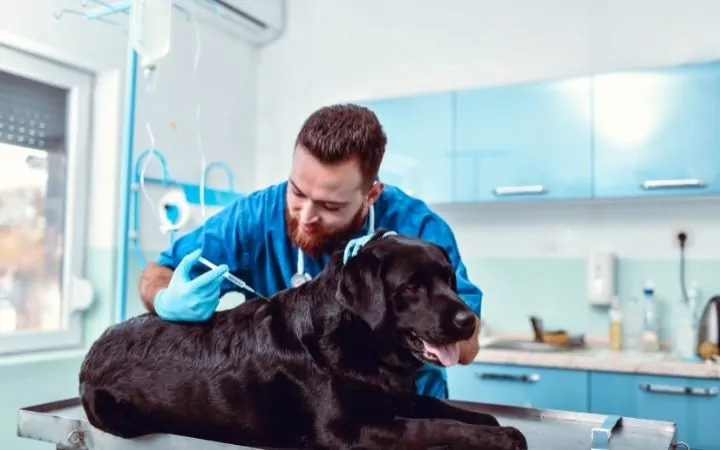What is Canine Osteomyelitis?
Osteomyelitis is a mouthful of a word. When we break it down into its components, it really just means bone (osteo-) and bone marrow (myel-) inflammation (-itis). When we think of osteomyelitis in dogs medically, we are talking about infection in bone and bone marrow.
Infections in bone causing osteomyelitis are usually caused by bacteria but in rare cases can also be caused by fungi; in this article, we will explain how dogs get osteomyelitis, how we diagnose it, and what can be done to treat and manage this disease.
The Types of Bacteria that Causes Osteomyelitis

As mentioned above, infections that cause osteomyelitis in dogs are usually caused by bacteria.
Most bacterial infections are caused by bacteria that require oxygen (aerobic). Specific types include Staphylococcus, Streptococcus, Escherichia, and Pseudomonas species, just to name a few.
Anaerobic bacteria will only populate in a bone in rare circumstances, such as when blood supply is lost (necrosis). Multiple bacteria can also cause infections at once (polymicrobial). This is especially common in infections that develop when the bone is exposed to the outside world, for example, in an open fracture.
Fungi can also rarely infect the bone. Some species are only native to North America and include Coccidioides immitis and Blastomyces dermatitidis found in Southern USA. Aspergillus species of fungi can also infect the bone and have a worldwide distribution.
Osteomyelitis – The Clinical Signs
The clinical signs of osteomyelitis in dogs you might notice include signs associated with infection and inflammation.
In dogs with osteomyelitis, some common clinical signs include:
- Lameness and limping in the affected leg can be episodic.
- Fever is common in animals fighting an infection.
- Lethargy as your pet’s body is using its energy to try and fight infection.
- General weakness due to the infection in the body.
- Inappetance is common in animals with fevers.
- Pain when the affected bone is touched.
- Wasting of muscles over the affected bone due to disuse.
- Swelling of the tissues surrounding the affected bone.
- Abscesses can develop, which can drain fluid or pus. This is common when a piece of bone is dead inside the leg, and the body has walled it off. When this occurs, we call it a sequestrum.
If you notice any of these signs in your pet, it is essential you bring them to your veterinarian to be examined.
The Causes of Osteomyelitis

Osteomyelitis occurs when bacteria infiltrate bone and bone marrow and proliferate, leading to an infection that overwhelms the body’s defenses.
There are multiple ways bacteria can come into contact with bone to be able to establish an infection:
- Fractures, particularly when the bone is exposed, can lead to infection.
- Implants can trap bacteria and allow them to increase, mainly because bacteria can use the implant to develop a biofilm that acts as an armor preventing the body from removing the infection. Infections from implants can develop within days or even months after surgery.
- Penetrating wounds such as a gunshot or biting and claw wounds can introduce bacteria into the body and cause osteomyelitis.
- Systemic infections in the dog’s body can spread to bones via the blood (hematogenously).
- Loss of blood supply to the bone or tissue surrounding bone can set up an environment perfect for bacteria, particularly anaerobic bacteria, as mentioned above. This can occur in a trauma situation or during/after surgery.
- Tooth root infections from diseased teeth can lead to infection of the surrounding bone in the jaw.
- Neonatal animals can develop osteomyelitis while bones are growing and blood vessels are developing.
- Surgery can introduce infection into the bone if proper sterile techniques and appropriate antibiotics aren’t utilized.
- Compromised immune systems such as those in pets undergoing chemotherapy may be more prone to developing infections.
Infection of bone and bone marrow can take days, weeks, or even months to establish after exposure to an infectious agent. It is important to note that even without an immediate cause, your pet could still develop osteomyelitis.
Diagnosis

To be able to diagnose osteomyelitis, your dog would need to be seen by a veterinarian. A veterinarian may suspect osteomyelitis after examining your pet and asking for a thorough history. If the affected leg has a history of trauma or surgery, this may increase suspicion of osteomyelitis.
Diagnostic tests would likely be required to confirm osteomyelitis. X-rays are commonly performed to diagnose osteomyelitis as it allows for visualization of the affected bone. On x-ray, a bone affected by osteomyelitis will look abnormal, and if an implant is present, there may be gaps around the screws. There may also be a fragment of bone walled off from the rest of the bone (sequestrum).
It is important to note that x-rays often show bone changes that lag behind what is actually going on in real life by about ten to 14 days. This means that although an x-ray might not show infection, it could still be occurring, and repeating the x-ray at a later time may be necessary to see the changes associated with osteomyelitis.
There may be signs of infection with raised levels of white blood cells (the body’s primary defense against infection) on blood work.
A swab can be collected from the affected leg to see what bacteria are present, helping tailor treatment options. This is called a culture and sensitivity test.
Other tests such as biopsy and ultrasound may be recommended if your vet feels they will help with diagnosis.
How is Osteomyelitis in Dogs Treated?

Osteomyelitis is a severe condition and, left untreated, can be life-threatening. It is essential that if your dog is diagnosed with osteomyelitis that appropriate treatment is instigated as soon as possible.
Depending on the exact cause, treatment can vary. Most commonly, antibiotics will be prescribed unless fungi are shown to be the cause of infection. Your veterinarian will prescribe a specific antibiotic type depending on the type of infection present and whether culture was performed.
If your dog is put on antibiotics, this will likely be a long course. It is essential that you finish the entire course and give the antibiotics as prescribed at the correct dose and frequency.
Pain relief can also be prescribed if your dog needs it. If it is found that a fungus is causing the infection, your dog will be put on antifungals.
If an implant is in the affected leg, this may need to be removed to help with treatment.
Any other specific causes will need to be addressed, such as systemic infection, fractures, bone/tissue death (necrosis), and dental work for tooth root abscesses. Your dog may require surgery, and the treatment could last several months.
In the worst case, scenario amputation of the affected limb may be required if infection can’t be resolved and infection is at risk of spreading throughout the rest of your pet’s body.
Living and Management of Osteomyelitis

With appropriate treatment, osteomyelitis can be treated, and your dog can make a full recovery. However, the prognosis is very variable and depends on many factors, including the type of bacteria or fungus involved, your pet’s health, and the cause of the infection.
In general, infections that occur acutely (within days) usually resolve faster, whereas infections that are there for months can take a lot longer to settle with treatment.
If your dog requires surgery, it will be important that post-operative care is done at home, along with any medications being given as prescribed. Dogs that have amputations can live normal lives once fully recovered.
Highlights and Key Takeaways
- Osteomyelitis is the infection of bone and bone marrow.
- This occurs when the bone comes into contact with an infectious agent, most commonly bacteria and rarely fungi.
- When an infection develops in the bone, you will see signs associated with infection and inflammation.
- Diagnosis of osteomyelitis may include imaging and sampling the affected site.
- It is essential that your pet receives adequate medical treatment. Your pet may need to be on medicine for a long time.
- In some cases, surgery is required to treat osteomyelitis, such as by removing implants, removing pieces of the affected bone, or in the worst-case scenario amputating the affected leg.
- With appropriate medical management the prognosis of osteomyelitis is good, but this can vary depending on the type of infection and how long it has been present.
